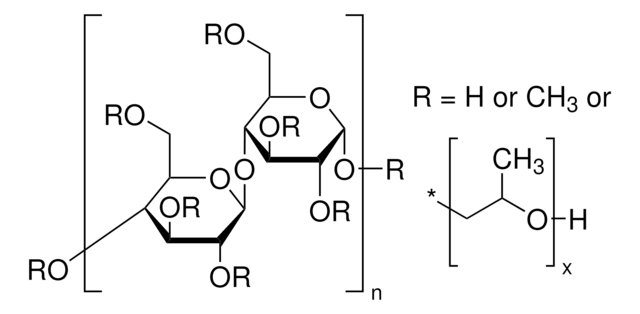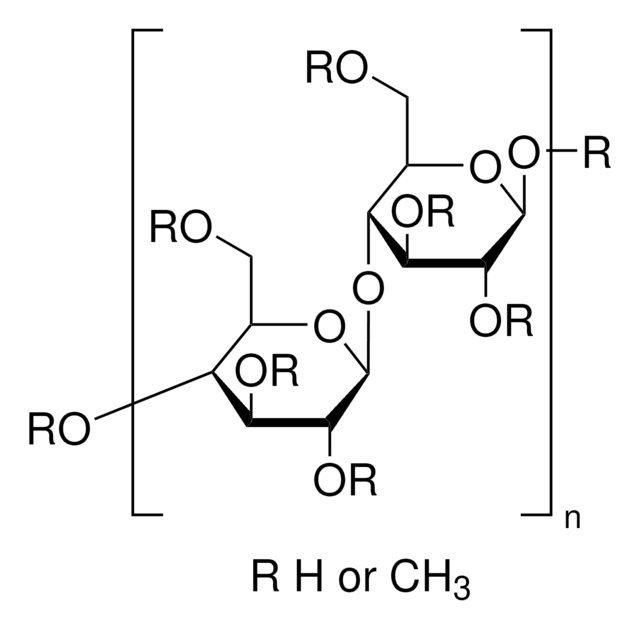H8384
(Hydroxypropyl)methyl cellulose
viscosity 40-60 cP, 2 % in H2O(20 °C)(lit.)
Synonym(s):
2-Hydroxypropyl methyl cellulose ether
Sign Into View Organizational & Contract Pricing
All Photos(4)
About This Item
Recommended Products
form
powder
Quality Level
mol wt
~22 kDa
color
beige
viscosity
40-60 cP, 2 % in H2O(20 °C)(lit.)
solubility
water: 10 mg/mL, clear to slightly hazy
storage temp.
room temp
Looking for similar products? Visit Product Comparison Guide
Application
Thickener for aqueous and non-aqueous systems, clear films with grease resistance, binders, lubricants, steric stabilizer and water retention aid.
Features and Benefits
Dissolves in water, undergoes reversible gelation upon heating, non-ionic, does not complex with ionic species and is surface active and enzyme resistant. Solutions are pseudoplastic.
Quality
Normally contains some iron particles.
Preparation Note
This product is soluble in water (10 mg/ml). However, it is very important to thoroughly disperse the particles in water with agitation before they will dissolve. Otherwise, they will lump and form a gelatinous membrane around the internal particles, preventing them from wetting completely. There are four dispersion techniques commonly used to prepare solutions of hydroxypropylmethylcellulose: dispersion in hot water, dry blending, dispersion in non-solvent medium, and dispersion of surface-treated powders. (The last method is only for surface-treated powders).
Dispersion in hot water:
1. Heat approximately 1/3 the required volume of water to at least 90 oC.
2. Add the powder to the heated water with stirring or agitation.
3. Agitate the mixture until the particles are thoroughly wetted and evenly dispersed.
4. Add the remainder of the water (cold water) to lower the temperature of the dispersion. As the product cools, it will reach a temperature at which it becomes water soluble. It will then begin to hydrate and dissolve, increasing the viscosity of the solution.
5. Continue agitation for at least 30 minutes after the proper temperature is reached for solubility. The solution is now ready to use.
Dry blending:
1. Combine powder with other dry ingredients. The suggested ratio of dry powder to hydroxypropylmethylcellulose is 7:1 to 3:1.
2. Thoroughly blend the dry ingredients.
3. Add the dry mixture to water with agitation.
4. Agitate until the product has completed hydrated and the solution is consistently smooth. The solution is now ready for further processing/use.
Dispersion in non-solvent medium:
1. Hydroxypropylmethylcellulose may be dispersed in non-solvent media such as vegetable oil, polyethylene glycol, glycerin, corn syrup, and concentrated salt solutions. A ratio of 5-8 parts non-solvent to 1 part hydroxypropylmethylcellulose is recommended to obtain a liquid slurry.
2. Agitate the mixture until the particles are evenly dispersed.
3. This dispersion may be added to cold water or cold water may be added to the dispersion.
4. Continue mixing until the powder is completely hydrated and the solution is smooth. Additional ingredients may now be added to the formulation.
Dispersion in hot water:
1. Heat approximately 1/3 the required volume of water to at least 90 oC.
2. Add the powder to the heated water with stirring or agitation.
3. Agitate the mixture until the particles are thoroughly wetted and evenly dispersed.
4. Add the remainder of the water (cold water) to lower the temperature of the dispersion. As the product cools, it will reach a temperature at which it becomes water soluble. It will then begin to hydrate and dissolve, increasing the viscosity of the solution.
5. Continue agitation for at least 30 minutes after the proper temperature is reached for solubility. The solution is now ready to use.
Dry blending:
1. Combine powder with other dry ingredients. The suggested ratio of dry powder to hydroxypropylmethylcellulose is 7:1 to 3:1.
2. Thoroughly blend the dry ingredients.
3. Add the dry mixture to water with agitation.
4. Agitate until the product has completed hydrated and the solution is consistently smooth. The solution is now ready for further processing/use.
Dispersion in non-solvent medium:
1. Hydroxypropylmethylcellulose may be dispersed in non-solvent media such as vegetable oil, polyethylene glycol, glycerin, corn syrup, and concentrated salt solutions. A ratio of 5-8 parts non-solvent to 1 part hydroxypropylmethylcellulose is recommended to obtain a liquid slurry.
2. Agitate the mixture until the particles are evenly dispersed.
3. This dispersion may be added to cold water or cold water may be added to the dispersion.
4. Continue mixing until the powder is completely hydrated and the solution is smooth. Additional ingredients may now be added to the formulation.
Other Notes
To gain a comprehensive understanding of our extensive range of Polysaccharides for your research, we encourage you to visit our Carbohydrates Category page.
Storage Class Code
11 - Combustible Solids
WGK
WGK 1
Flash Point(F)
Not applicable
Flash Point(C)
Not applicable
Personal Protective Equipment
dust mask type N95 (US), Eyeshields, Gloves
Certificates of Analysis (COA)
Search for Certificates of Analysis (COA) by entering the products Lot/Batch Number. Lot and Batch Numbers can be found on a product’s label following the words ‘Lot’ or ‘Batch’.
Already Own This Product?
Find documentation for the products that you have recently purchased in the Document Library.
Customers Also Viewed
Akio Suzuki et al.
PloS one, 14(6), e0217944-e0217944 (2019-06-07)
Anti-prion protein (PrP) monoclonal antibody 132, which recognizes mouse PrP amino acids 119-127, enables us to reliably detect abnormal isoform prion protein (PrPSc) in cells or frozen tissue sections by immunofluorescence assay, although treatment with guanidinium salts is a prerequisite.
Rebecca Soffe et al.
PloS one, 14(6), e0218102-e0218102 (2019-06-07)
Artificial surfaces are routinely used instead of leaves to enable a reductionist approach in phyllosphere microbiology, the study of microorganisms residing on plant leaf surfaces. Commonly used artificial surfaces include, flat surfaces, such as metal and nutrient agar, and microstructured
A Akbarian et al.
Poultry science, 93(8), 1930-1941 (2014-06-17)
Heat stress in poultry is a serious problem in many countries and has been associated with oxidative stress. Hence, nutritional interventions with antioxidants might be beneficial. Therefore, the effects of dietary Curcuma xanthorrhiza (CX) and Origanum compactum (OC) essential oils
Francis W Hunter et al.
Biochemical pharmacology, 89(2), 224-235 (2014-03-19)
The nitro-chloromethylbenzindoline prodrug SN29428 has been rationally designed to target tumour hypoxia. SN29428 is metabolised to a DNA minor groove alkylator via oxygen-sensitive reductive activation initiated by unknown one-electron reductases. The present study sought to identify reductases capable of activating
Michelle Lay Teng Ang et al.
Infection and immunity, 82(5), 1850-1859 (2014-02-26)
Tuberculosis remains a major worldwide epidemic because of its sole etiological agent, Mycobacterium tuberculosis. Ethionamide (ETH) is one of the major antitubercular drugs used to treat infections with multidrug-resistant M. tuberculosis strains. ETH is a prodrug that requires activation within
Our team of scientists has experience in all areas of research including Life Science, Material Science, Chemical Synthesis, Chromatography, Analytical and many others.
Contact Technical Service


